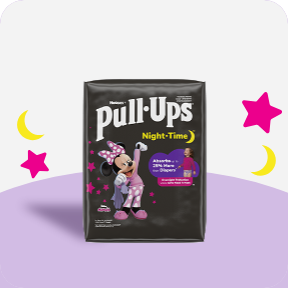How to Potty Train
3 Day Potty Training Method
18 Jan, 2023
4 min. Read
You’ve probably heard of potty training a child in a weekend — sometimes called a 3-day potty training boot camp — and wondered if these programs actually work. The answer? Not often! The three-day potting training method assumes that potty training is a simple process and that once your toddler learns the new routine, they’ll simply march their way to the bathroom. This may work with kids who have easygoing personalities and like to follow the rules, but it’s safe to say that toddlers like that aren’t the majority. If you’re looking for a more realistic approach, read on for some ideas!The Pull-Ups® Potty Training Method — based on tried-and-true potty training methods supported by the American Academy of Pediatrics and the American Academy of Family Physicians — brings together loads of great advice on potty training, including ways to make potty training fun. So, whether you’ve already tried a method that didn’t work for your toddler or you’re just starting to think about potty training, you’ll find all kinds of helpful information on this site.
If your child shows at least two signs, they might be ready to start. If you’re still unsure, take this Potty Training Readiness Quiz to help you decide.
Things to Consider Before Starting the 3 Day Potty Training Method
Step 1: How to Prepare for Potty Training in 3 Days
Kids are ready to potty train at different ages, so it’s important not to get stuck on a number. Instead, watch for signs that your toddler is ready to start potty training, including these:- Pulling at a wet or dirty diaper.
- Hiding to pee or poop.
- Showing interest or copying the behavior of people who are using the bathroom.
- Staying dry in their diaper for longer than usual.
- Waking up dry from a nap.
- Telling you that they’re about to go or have just gone.
Step 2: Understanding Your Child’s Potty Personality
Even if you’ve already potty trained a big brother or sister, you’ll surely notice that no two kids are alike — in potty training or any other area. Once you’ve determined their personality, you can access tips tailored to their personality. Take this quiz to determine their potty personality, and click below for a sneak peek of what you might learn:- Shy Personality: Nervous, resistant to change
- Cautious Personality: Follows directions, careful and detailed
- Eager-to-Please Personality: Ready and willing
- Free-Spirited Personality: Independent, fun-loving
- High-Energy Personality: Driven, energetic, easily distracted
Step 3: Gathering Essentials for the 3 Day Potty Training Method
Before you kick off potty training, make sure you have everything you need. Some items to include in your at-home kit may be:- A small potty or child potty seat
- A step stool
- Pull-Ups® training pants
- Underwear
- Foamy soap (kids love it!)
- A reward chart and other incentives






















